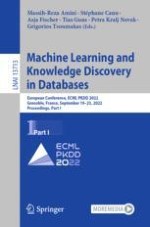2023 | OriginalPaper | Chapter
SECLEDS: Sequence Clustering in Evolving Data Streams via Multiple Medoids and Medoid Voting
Authors : Azqa Nadeem, Sicco Verwer
Published in: Machine Learning and Knowledge Discovery in Databases
Publisher: Springer International Publishing
Activate our intelligent search to find suitable subject content or patents.
Select sections of text to find matching patents with Artificial Intelligence. powered by
Select sections of text to find additional relevant content using AI-assisted search. powered by
Abstract
k-centers being actual data items helps with cluster interpretability. However, offline k-medoids has no support for concept drift, while also being prohibitively expensive for clustering data streams. We therefore propose SECLEDS, a streaming variant of the k-medoids algorithm with constant memory footprint. SECLEDS has two unique properties: i) it uses multiple medoids per cluster, producing stable high-quality clusters, and ii) it handles concept drift using an intuitive Medoid Voting scheme for approximating cluster distances. Unlike existing adaptive algorithms that create new clusters for new concepts, SECLEDS follows a fundamentally different approach, where the clusters themselves evolve with an evolving stream. Using real and synthetic datasets, we empirically demonstrate that SECLEDS produces high-quality clusters regardless of drift, stream size, data dimensionality, and number of clusters. We compare against three popular stream and batch clustering algorithms. The state-of-the-art BanditPAM is used as an offline benchmark. SECLEDS achieves comparable F1 score to BanditPAM while reducing the number of required distance computations by 83.7%. Importantly, SECLEDS outperforms all baselines by 138.7% when the stream contains drift. We also cluster real network traffic, and provide evidence that SECLEDS can support network bandwidths of up to 1.08 Gbps while using the (expensive) dynamic time warping distance.